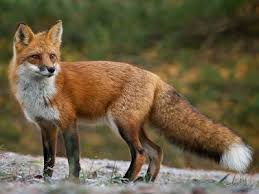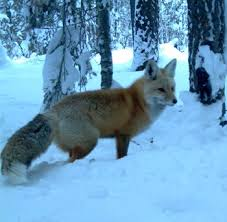This week we are looking at the Sierra Nevada red fox.
Then we have the Sierra Nevada red fox which is found in the
mountainous regions of California's Sierra Nevada, it is also considered endangered.
It is threatened by unpredictable events like wildfire and drought, competition
with coyotes, and hybridization with non-native foxes, as well as habitat loss
from logging and livestock grazing, disturbance by recreational vehicles, and
climate change.
The Sonora Pass population of
the Sierra Nevada red fox may be one of the most endangered species
in the U.S. When FWS listed this population as endangered in 2021, the agency
estimated that as few as 39 individuals may remain in the wild.
They appear to be
opportunistic predators and foragers, with a diet primarily composed of small
rodents. Their favorite foods are hares and gophers, but they also eat
manzanita berries and deer carrion, particularly in winter and spring.
They have a small, slender
body and legs; long, pointed ears; an elongated snout; and a long, white-tipped
tail. They're typically smaller than lowland red fox subspecies, with males
weighing up to 9.2 pounds and measuring up to 3.4 feet long and females up to
7.7 pounds and 3.2 feet.
The biggest difference between it and the Red Fox is the Sierra
Nevada red fox's specialized adaptations for cold and snow. They have
well-furred paws as part of their winter coat, longer hind legs and are
slightly smaller.
They mate between December and March, with most mating
occurring in January and February. They are believed to be monogamous.
They are sexually mature at 10 months they have a gestation
period of 52–54 days, they can give birth to litters of 1–12 kits, with an
average of 3–6 kits they are born in early to mid-April the pups move outside
the den by June and are dependent on parents for 6 months.
They prepare multiple dens after mating and may share a burrow
with another pair.
A conservation strategy is being developed to help recover the
Sierra Nevada red fox. The strategy includes translocations and introducing
other alpine foxes to support breeding.
The Forest Service, Park Service, and Department of Defence have
resource management plans to minimize forest fragmentation.







They are so beautiful!
ReplyDeleteYes they are
DeleteThe red fox has a very sexy face and body, but the body is low to the ground and the eyes look cunning. I am not surprised he is a successful predator.
ReplyDeleteThat's for sure
DeleteCute faces, and good information Jo-Anne.
ReplyDeleteThanks
DeleteThese are the guys I'm very familiar with. I live very close to their territory. They are gorgeous in person.
ReplyDeleteWow, lucky you
DeleteI want one!
ReplyDeleteI get that feeling
DeleteThey do look a lot like the red fox. Pretty, agile, and graceful. :)
ReplyDeleteThat they do
DeleteHaven't seen a fox in a while, but there was just a raccoon in a very empty dumpster. Hopefully he can use the rug I threw away as a ramp to get out...
ReplyDeleteOr as a blanket if he is cold
DeleteThis is an informative and well-structured piece that highlights both the ecological significance and conservation challenges of the Sierra Nevada red fox. The details on their adaptations, diet, and reproduction provide valuable insight, while the discussion of conservation efforts underscores the urgency of protecting this endangered species.
ReplyDelete